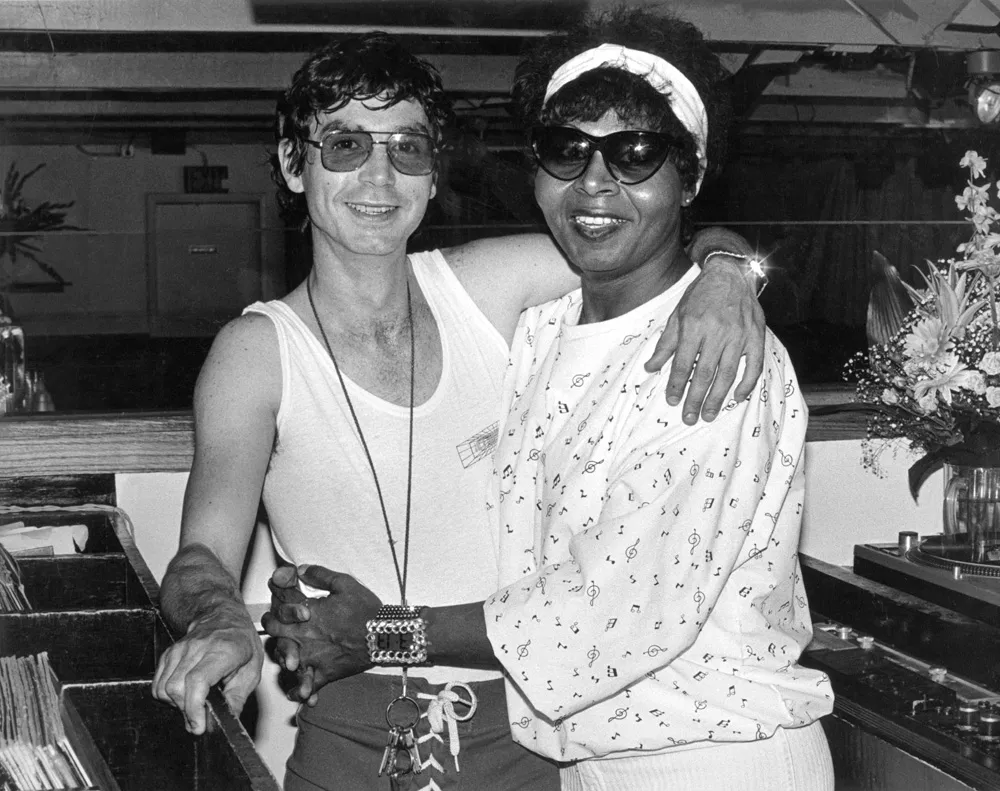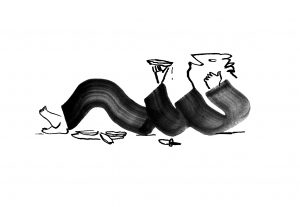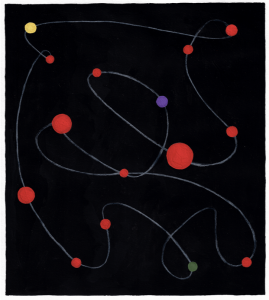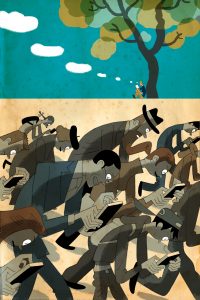Poet and scholar Jack Parlett shares an extract from his newly published book, a sprawling account of New York’s Fire Island and its influence on culture and queer liberation over the past century

Loving the Dances
For three days at the end of June 2019, New York came to its knees in celebration. On the Friday evening of WorldPride and the fiftieth anniversary of the Stonewall riots, the West Village was inundated. I’d rarely seen so many queer people in one neighborhood before. The scene was bathed in dusk, lit up by streetlamps, fairy lights and the glow of phone screens capturing the moment. En route to a night of dancing, we passed the Stonewall Inn, where a crowd of people had congregated. Many of them weren’t particularly bothered about getting in— the line extended a whole block—and a street party was unfolding outside the bar. Whitney Houston’s “I Wanna Dance with Somebody” rang out from a large speaker. All around us, that intricate intersection where the city’s grid system gives way to the mosaic of Christopher Street, Seventh Avenue, West Fourth and Sheridan Square, stages were being constructed and railings put in place. The scaffolding for Pride was being raised, but the party had already started.
Whitney’s 1987 hit felt like an apt anthem for the anniversary. Stonewall began with dancing, after all. Even if what was at stake came to feel much bigger in the course of the fifty-plus years since, those events effectively politicized the right to dance with “somebody who loves me,” whomever that may be. Claiming the right to dance, an act that stands for a whole host of freedoms, gained greater urgency in the years leading up to June 1969. It is hardly surprising that dancing defined the 1970s, the decade of both gay liberation and disco.
While the tea dance presented Fire Island’s own spin on the phenomenon, there were gay dances in the city that were more obviously political in theme. Of course, one didn’t have to be expressly political to go to them. When the artist John Button was asked some years after Frank O’Hara died about what the poet would have thought about gay liberation, he replied: “Oh, he would have thought it was silly, but he would have loved the dances!” Button himself had been at many of these dances— he was involved in creating a mural for the venue where they took place, an iconic but short-lived venue in SoHo known as the Firehouse.
The disused firehouse had been taken over in 1971 by the Gay Activists’ Alliance (GAA), which was formed by members who broke away from the more antiestablishment Gay Liberation Front and advocated for gay civil rights. Every Saturday, weekly dances at the Firehouse were attended by hundreds and sometimes even thousands, who paid two dollars entry for a good time, and helped to keep the organization afloat in the process. The dances were described as a heavenly “cross between Woodstock Nation and Dante’s Inferno.” Until it burned down in an arson attack in 1974, the Firehouse had provided a sense of balance, a symbiosis between politics and pleasure—it was a community center by day and a discotheque by night. The apocryphal spirit of Emma Goldman, the oft-misquoted anarchist of the early twentieth century, seemed alive and well: “If I can’t dance, it’s not my revolution.”
In the Pines, it would still be some years before the ethos of the political dance took hold, at a legendary 1979 beach party held to raise funds for a new fire truck. That party would seem, in many respects, to be a climax of the hedonistic and liberatory decade that had come before. But on the island, political involvement and the pleasures of the dance floor did not go naturally hand in hand in the intervening years. The island’s dancing establishments were essential spots in the history of disco. As Tim Lawrence shows, elements of disco culture were arguably born out of the rivalries between the Ice Palace in the Grove and the Botel and the Sandpiper in the Pines, a one-story, driftwood building on the harbor that functioned as a restaurant in the early evening and a discotheque by night, flooded with up to six hundred dancers on weekends. The model-turned-disk-jockey Tom Moulton innovated the form of the extended mix and the mixtape in the summer of 1972 when, sick of hearing DJs botch the transitions between two-minute songs, he put together a tape of nonstop music and handed it to the owners of the Sandpiper. Other places began to follow suit.
The island’s discotheques were vibrant churches of music and movement, and with the advent of Moulton’s mixes and their imitations, the early-1970s vogue for funk and soul—he remembers seeing “all these white people dancing to black music” during his visit to the island—gave way to that elongated and danceable mode we know as disco. But although they attracted dancers gay and straight to the island in droves, these summer parties offered something harder to reach, literally and metaphorically, than the GAA’s community dances back in the city. At the Firehouse, prominent members of many of the era’s activist groups could regularly be seen, including Johnson and Rivera, who had set up their own activist organization, the Street Transvestite Action Revolutionaries (STAR). The Fire Island discos were commercial enterprises that served the needs, desires and newfound freedoms of a community, but they were not exactly hotbeds of radicalism.
Someone who understood this intimately was Andrew Holleran, real name Eric Garber, whose eulogy for the era’s dance floors, 1978’s Dancer from the Dance, is still for many the island’s gospel—the “Great Pines Novel.” Born and raised in Florida and a graduate of Harvard, Holleran moved to New York in 1971 after short stints in the army, at law school in Philadelphia, and at the Iowa Writer’s Workshop. Like many of the gay men who moved to the city in the late 1960s and 1970s, what he found there was a place of unprecedented freedom: a mecca of sex and drugs, dancing and socializing. He spent a number of years in the city temping while he wrote fiction on the side. In fact, being a gay man on the scene in this era was a vocation in itself. The “body […] the thing that had not seemed important at Harvard,” had now become “crucial”; while at college he would have been pondering over a Henry James novel, now he found himself “wondering how to combine brewers’ yeast with my morning milkshake because I needed the extra protein for the body-building I was doing at the gym.”
It was around 1972 that Holleran first went to Fire Island. During his first two summers there, he worked for a bus company that operated a service from midtown Manhattan to the Sayville ferry dock, trips made notoriously boozy by excitable islanders eager to reach the licentious shore. Working this job allowed Holleran to stay with other workers in the Pines property known as the Bus House. There he made close friends and learned the ways of gay life. The house apparently once bore a mocking sign that said something like “Fire Island Academy of the Arts,” a satirical nod to the fact that it was usually the body, not the intellect, that won out there. Fire Island hardly lacked an intellectual culture. In the late 1950s, when James Purdy’s cult novel Malcolm was published, one islander remembers how men “bronzed on the beach as they read the novel […] in order to be prepared for the discussion that would invariably dominate conversation at that evening’s social gatherings.” But for all the literary and theater queens in attendance, it was not chic to overintellectualize in 1970s Pines society. As Ethan Mordden’s narrator writes, in a story featuring a thinly fictionalized depiction of Holleran, his friend, on Fire Island, the “beguiling but often irrelevant data of talent and intelligence that can seem enticing in the city are internal contradictions in a place without an opera house or a library.”
Naturally, amid the dances and the dinner parties, the afternoons drying out on the beach and the dropping of pills at twilight, there wasn’t much time left for politics either. As the narrator puts it at the end of Holleran’s novel, recalling a gay liberation march in Central Park at which he recognized no more than “four or five faces” from that “sea of humanity,” many gay men were “at the beach, darling; they couldn’t be bothered to come in and make a political statement.” The statements to be made on the island were quite consuming enough, it seemed. It was there that one cruised and camped and went on show at tea and along the beach, in the hope of attracting the gazes of known and unknown faces; four or five, perhaps, or maybe many more.
There was also a trend for gay men’s erotic lives to relate, even in small ways, to their activism; the tearing down of boundaries and ripping up of rulebooks. There would be extensive foot traffic in any given Pines house-share: renters, their friends or houseguests, and the more transient visitors encountered on the dance floor or the boardwalk, who were swiftly ushered into the bedroom. For the more populated houses, where privacy was at a premium, the Meat Rack provided not only an alfresco frisson, but a practical public alternative for consummating the stirred-up desires of brief encounters. In some houses, everyone was in on the action anyway. The underrated 1973 film A Very Natural Thing shows a young gay couple who venture to Fire Island for the weekend and have an orgy with their housemates on the living room floor. One of them is into it, the other less so; casual group sex doesn’t match his idea of a committed relationship.
There were plenty of monogamous couples treading the boards of the island’s gay scene. But as queer sexuality emerged from the shadow of repression and traditional models of kinship, confining yourself to one partner was not the order of the day in the sex-positive ’70s. The city had ample orgiastic possibilities, not least in the basement darkrooms of its bars and clubs, and Fire Island was particularly synonymous with sexual license and multitudes, whether in the wild terrain of the Meat Rack or in some grand modernist home overlooking the ocean. Casual sex and nameless sex, sex “good” and “bad”; these were part and parcel of liberation’s bounty. Perhaps nowhere else on earth quite offered so many sexual opportunities in such a concentrated space, flanked by the boundlessness of the Atlantic.
There were, as the saying goes, so many men, so little time. Time itself signalled trouble in paradise. Each year the seasons would change and the island would wind down for another year, a welcome relief after months spent in its pressure-cooker environment. But each year one also got older. Was there an expiration date to the dream of limitless sex and intimacy, the conviction that casual encounters were not meaningless, or rather, that they needn’t be meaningful by traditional (straight) standards? Would promiscuity mean the same thing at age fifty, or forty, as it did at thirty? And at what age does one become a doomed queen—that old gay trope—the love-starved solitary who hides his loneliness behind camp humor? Aging in—or, in fact, out of—a community driven by youth, beauty and availability could be difficult for the men who tried to keep up. Even the beauties who spent the spring months in the gym in readiness for the island season could be sick with worry, like Holleran’s suicidal character, Frank Post. To be sexually liberated on Fire Island was no plain sailing.
Fire Island is published by Granta, 26th May, 2022




